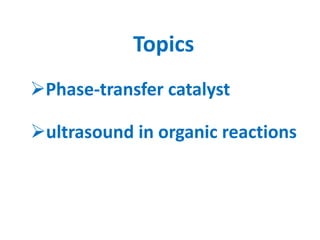
Phase transfer catalyst and ultrasound in organic recation .pdf
- 1. Topics Phase-transfer catalyst ultrasound in organic reactions
- 2. Phase transfer catalyst Phase-transfer catalyst (PTC) is a catalyst that facilitates the Migration of a reactant from one phase into another phase where reaction occurs. Chem. Rev. 2018, 118, 18, 8770–8785 Phase-transfer catalysis (PTC) has been widely used for the synthesis of organic compounds for more than five decades.
- 3. Why we need to use phase transfer catalyst? 2. Moreover, Phase-transfer catalysts are useful in green synthesis by allowing water as solvent. 1. A phase-transfer catalyst enables the reaction in a heterogeneous system between general organic compounds soluble in organic solvents and compounds soluble in water such as inorganic salts. J. Pure and App. Chem., 2000,72, 7, 1399-1403. J. Am. Chem. Soc. 1971, 93, 1, 195–199
- 4. Type phase transfer catalyst Phase-transfer catalysts for anionic reactants are often quaternary ammonium salts. Some commercially available phase transfer catalysts are benzyltriethylammonium chloride, methyltricaprylammonium chloride, methyltributylammonium chloride, and methyltrioctylammonium chloride. Phase-transfer catalyst,Wikipedia, The Free Encyclopedia. 2023
- 5. Type phase transfer catalyst Halpern, M. (2000) , Ullmann's Encyclopedia of Industrial Chemistry. Organic phosphonium salts are also used, e.g., hexadecyltributylphosphonium bromide. The phosphonium salts tolerate higher temperatures, but are unstable toward base, degrading to phosphine oxide. Many commercially available crown ether can be found easily and are employed as a PTC in various kinds of reactions. The role of crown ether as PTC in polymer science are also diversely studied. Molecules 2021, 26(21), 6542
- 6. Mechanism of Phase transfer catalyst In general, there are two immiscible phases in reaction mixture, viz. an aqueous phase which contains a salt (a base or nucleophile) and the other an organic phase containing the substrate which is expected to react with the salt. Chem. Rev. 2018, 118, 18, 8770–8785
- 7. When a phase transfer catalyst (usually contains a lipophilic cation) is added to the reaction mixture, the lipophilic cation (which has solubility in both aqueous and organic phases), exchanges anions with the excess of anions in the salt solution. J. Am. Chem. Soc. 1971, 93, 1, 195–199 Then a phase transfer equilibrium exists as Once nucleophile or base comes in nonpolar (organic) media, the displacement can take place with the product formation. The overall mechanism can be represented as follows:
- 8. Advantages Phase transfer catalyst 1. Faster reactions rate 2. Higher conversions or yields 3. Lower byproducts formation 4. Reduce the need for expensive/hazardous solvents that will dissolve all the reactants in one phase 5. Phase-transfer catalysts are especially useful in green synthesis by allowing water as solvent. 6. PTCs can be employed in a wide variety of organic synthesis reactions, making them a versatile tool for chemists. 7. By enabling faster reactions, higher yields, and the use of less expensive solvents, PTCs can significantly reduce overall process costs. Molecular Catalysis, 2019, 466, 212-121
- 9. Application phase transfer catalyst 2. Asymmetric Oxidation reaction : Epoxidation 1. Improved Williamson ether synthesis using phase transfer catalysis 1.H. H. Freedman, R. A. Dubois, Tetrahedron Lett. 1975, 16, 3251 Matsumoto, K., Katsuki, T., Comprehensive Chirality, 2012, 5, 69-117
- 10. Application phase transfer catalyst 4. N-alkylation reaction 3. Carbon–Carbon σ-Bond Formation Kenkichi Sonogashira, Comprehensive Organic Synthesis, 1991 A. Krutošóková, T. Gracza, Comprehensive Heterocyclic Chemistry III, 2008 Guoshu Xie, ... Béla Török, Contemporary Chemical Approaches for Green and Sustainable Drugs, 2022
- 11. Ultrasound in chemical reactions Ultrasound is sound with frequencies greater than 20 KHz. This frequency is the approximate upper audible limit of human hearing in healthy young adults. when ultrasound is used to accelerate chemical reactions in solution. The process is called sonochemistry. Usually it uses frequencies 20 KHz to 40 KHz. The influence of ultrasonic waves travelling through liquids was first reported by Robert Williams Wood (1868–1955) and Alfred Lee Loomis (1887–1975) in 1927. Chem. Soc. Rev. 1997, 26, 443 J. Org. Chem. 2021, 86, 20, 13833–13856
- 12. Mechanism of Ultrasound’s use in reactions These bubbles act as micro reactors that offer the opportunity of speeding up certain reactions and also allow mechanistically novel reactions to take place in an absolutely safe manner. The use of ultrasound waves to create acoustic cavitation(Rapid formation and collapse of vapor bubble within liquid), which generates small, oscillating bubbles of gaseous substances in the liquid phase. Bobble formation Growth of Bobble to impulsion J. Org. Chem. 2021, 86, 20, 13833–13856
- 13. Advantages of use of ultrasound in reactions 1. Ultrasound Increases the rate of reaction by enhancing mass transfer and collision frequency. 2. It offer better selectivity of reactions by creating unique reaction conditions 3. By promoting efficient mixing and preventing side reactions, ultrasound can lead to higher yields of desired products. 4. Ultrasound is a clean and non-toxic technology, often requiring fewer and less hazardous reagents compared to traditional methods. 5. it can reduce energy consumption by accelerating reactions at lower temperatures. Chem. Soc. Rev. 1997, 26, 443
- 14. Application of ultrasound in organic reactions 2. Accelerates the speed of some know reaction 1. C3-cyanomethylated imidazo[1,2-a]pyridines preparation with satisfactory yields and good functional group compatibility. Zhang, Y. Zhang, J. Zhang, Q. Wu, Synlett, 2022, 33, 264-268 B. C. Ranu, A. Hajra, U. Jana, Org. Lett., 1999, 1, 1141-1143. W. Phakhodee, D. Yamano, M. Pattarawarapan, Synlett, 2020, 31, 703-707
- 15. Application of ultrasound in organic reactions 3. Alkylation and acylation reactions. Gharat, Neha N. - Rathod, Virendra K., Sonochemical Organic Synthesis, 2020, 1-4 4. Synthesis of Z and E stilbenes Gharat, Neha N. - Rathod, Virendra K., Sonochemical Organic Synthesis, 2020, 1-41
- 16. Thanks for your valuable attention